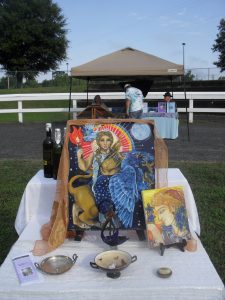Setting Up an Altar at Pagan Pride Day
By Lykeia

The informative aside, perhaps a more important way to represent Hellenismos is through hands on practice. While it would be lovely to be able to work with the organizers in order to set aside time to conduct a small ritual during the Pagan Pride festivities, this in itself is not entirely necessary if you are unable to do so. What is far more poignant is to have a central place of worship set up, not too far away from your booth so you can keep an eye on it and attend to it easily enough (trust me you do not want to be walking across the grounds every twenty minutes or so). That is to say, have an altar set up which people can approach and pay their respect to the god in question. This not only provides a more visually recognizable symbol of what religion you follow for those who may not know what Hellenismos or Hellenic Polytheism are, but it also gives people the opportunity to participate in a hands on libation and offering to the gods.
In constructing your altar there are several factors to keep in mind. The first is that it should not be of great size. At Pagan Pride Day you are usually allotted only so much room so something about the size of a small end-table or tv-dinner stand is of appropriate size for what you need to do. Second is to determine what deity or deities you wish the altar to be dedicated to. While it might be ideal to set up for all the Olympians you may find that you run into a space problem. Alternatively you can set it up for some specific god who has a festival particular to the season. For myself I chose to set up an altar to Apollon representing his departure to Hyperborea that I had celebrated just the day before in association with the autumnal equinox. Third, you will want to determine what supplies, or items, are going to be essential to represent an altar and regular worship of the gods. Keep in mind this often means forgoing incense and any source of fire because of park regulations if the Pagan Pride Day is being held in a park.
Some important features could be libation wine, for the altar to Apollon I specifically use honeyed wine in remembrance of his son Aristaios who was said to have the first to have mixed together the honey of his bees with the wine of Dionysos, as well as a bowl set before the altar containing barley for offerings, a short written description attached to the altar on how to perform an offering and libation should ideally be kept at the altar, and lastly some imagery representing the god. For the altar to Apollon I represented Apollon by a hand-painted image of him seated on a griffin departing for Hyperborea, as well as a small cast-iron figure wrapped in amber beads (to represent his mythic tears of his first exile to Hyperborea, that I placed upon a glass swan ornament. I also included a bowl with divination dice and a short discussion on how they were used and included a small jar that contained a pine nut from Delphi. Altogether this provided a central place where people could pass and make a prayer, even if they did not care to enter the booth itself. However, it should be advised that you don’t use anything that is really fragile or that you cannot replace if it disappears. Though theft rarely happens at a Pagan Pride Day, it certainly can happen. Also there is potential for things to get broken accidentally so those delicate little treasures really ought to stay at home. Additionally it doesn’t hurt to have something near the shrine (either at the altar itself or in the booth nearby) for children. The gods favor children and their presence at the altars and so small mementos and treats for them is ideal which can be set aside in a small box or basket on the ground beside the altar.
It is of course expected that in setting up the altar you would treat it as you would setting up an altar at home in setting it up, and also in making the initial prayer and offering to the god(s) upon establishing it. This also provides a visual example to those within view of it, of how to perform the prayer and offering. Likewise, having it set up in near proximity to your booth means you will be available to help if anyone needs assistance. Don’t be surprised if you get a bit of an audience while you are helping or doing the initial offerings. It tends to attract attention. In the end the altar is a nice addition to the booth, together providing worship and information to those that love the gods of Hellas. Or, if you don’t have the ability to run a booth (say for example that you aren’t in a position to cart over all that you would need for a booth) you can create just an altar with a basket of pamphlets near it for people to take as they visit. I would encourage anyone who would like to make such a resource available at their local Pagan Pride Day to contact their organizational committee and let them know that you are interested in adding this to the festival.
